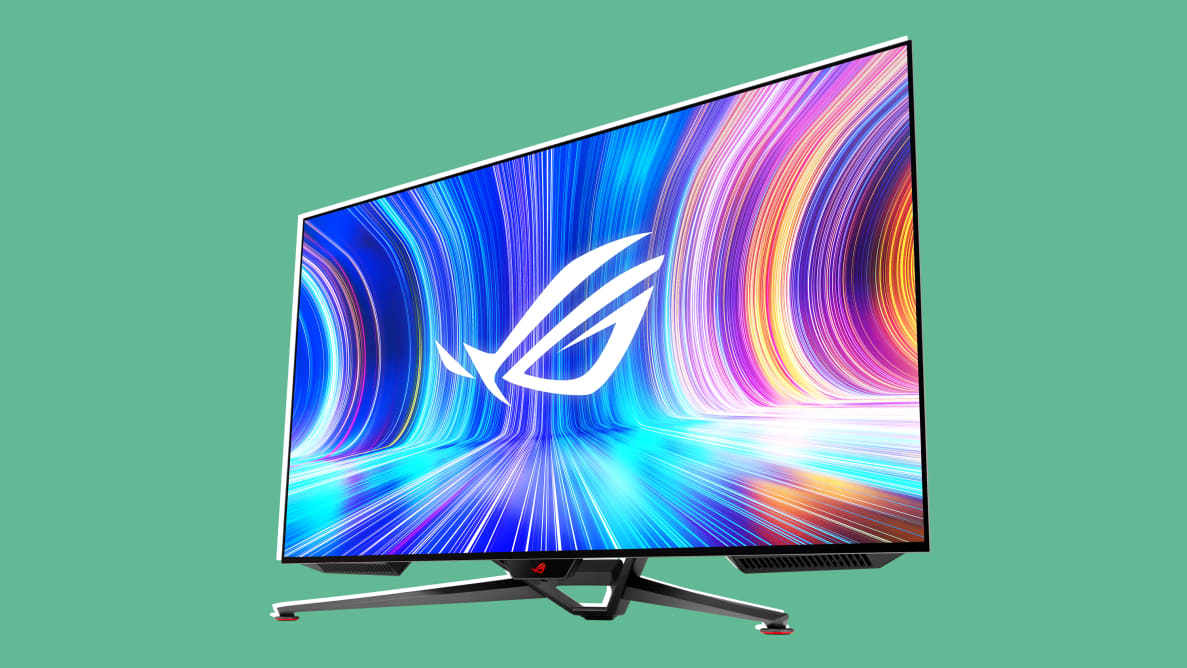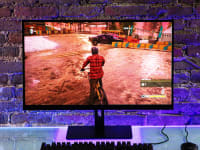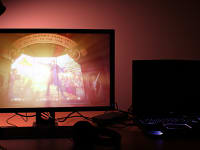Pros
-
Vibrant imagery
-
Smooth gaming motion
-
Versatile utility
Cons
-
Fussy OLED panel
-
Tricky to work around even on a big desk
While the monitor is far from perfect, and faces the same fuss that has plagued OLED displays for years, it can still shine bright and deliver heaps of 10-bit color that go a long way toward making a quality gaming and entertainment experience. At $1,400, it’s a big ask for a gaming monitor, but it’s a strong option if you want a display that pairs visual quality with substantial size.
About the Asus ROG Swift OLED PG42UQ
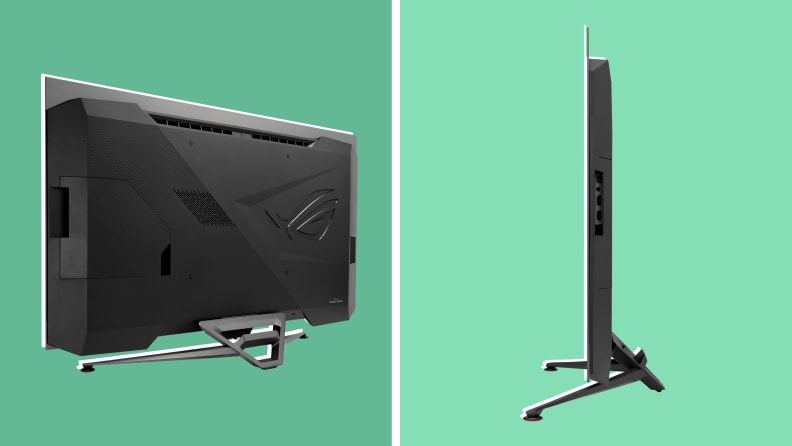
A closer look at the Asus ROG Swift OLED PG42UQ.
Here are the specs of the monitor we tested:
- Price: $1,400
- Display size: 41.5 inches
- Resolution: 3840 x 2160 pixels
- Refresh rate: 138Hz (OC)
- Peak brightness: 450 nits (rated), 140.4 nits (tested), 700 nits (with HDR)
- HDR support: HDR10
- Color depth: 10-bit
- Color saturation: 98% DCI-P3, 133% sRGB; 97% DCI-P3 (tested), 100% sRGB (tested)
- Contrast ratio: 135,000:1 (rated), 1.5M:1 (HDR rated), 9890:1 (tested)
- Pixel response time (GtG): 0.1ms
- Ports: 2x HDMI 2.1, 2 x HDMI 2.0, 1 x DisplayPort 1.4 (DSC), 1 x USB 3.0 (upstream), 4 x USB 3.2 Gen 2 (downstream), 1 x 3.5mm, 1 x SPDIF out
- VRR Support: G-Sync compatible
- Other features: VESA mount (300x300), tripod socket, 2.1-channel speakers, “uniform brightness,” factory pre-calibrated color, remote control, aspect control, tilt-adjustable stand
What we like
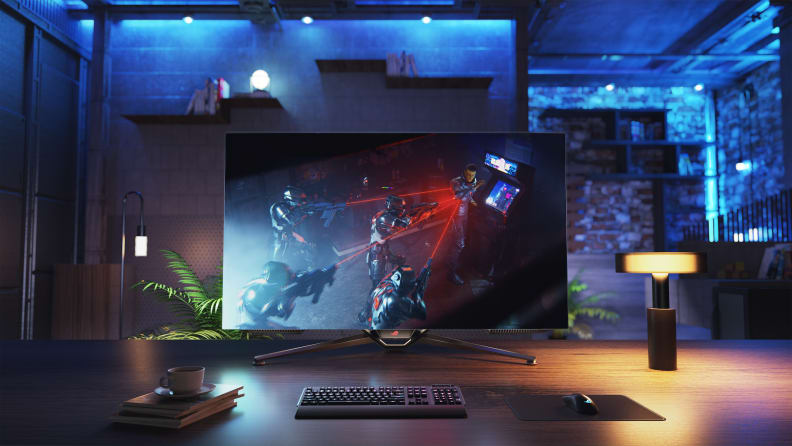
Very high resolution along with fast performance.
The extremely rich contrast
The Asus ROG Swift OLED PG42UQ enjoys one of the biggest benefits of OLED panels and puts it on full display at the desktop-domineering size of 41.5 inches. With pixels that can go completely black sitting right next to pixels I was able to measure above 700 nits, the contrast makes for incredibly poignant and dramatic visuals.
Space scenes especially benefit, with the pitch black of infinite space deliciously rendered next to the glare of stars and sunlight reflecting off spaceship hulls.
The contrast of the ROG Swift OLED PG42UQ pairs with a wide color gamut that doesn’t make for a dull moment when enjoying movies, TV, or games.
Excellent motion clarity
As a gaming monitor, the ROG Swift OLED PG42UQ has to be fast, and it delivers. It can push its 4K resolution at a 138Hz refresh rate once it’s overclocked, which is a simple process in the menus. For fast action, refresh rate is only half the battle.
Pixel response time is a huge factor, and it’s one that OLED panels excel at. As soon as a pixel needs to start displaying a new visual, they’ll switch near-instantly. IPS panels tend to be a bit slower, and VA panels are slower still. The result of that slowness is smear during fast movements. So even if the panel is refreshing at 240Hz or even 360Hz, it can be a blurry mess during fast action that’s hard to see through.
None of this smearing is present on the ROG Swift OLED PG42UQ. It’s not quite as impressive as the Alienware AW3423DW, which benefits from a faster 175Hz refresh rate for even better motion clarity, but it’s still a strong pro for the ROG Swift OLED PG42UQ.
It certainly helped me in the hours of Overwatch 2 I put into this panel, allowing me to keep up with the action without all the visual effects becoming a smeared mess.
The high level of versatility
The ROG Swift OLED PG42UQ is a gaming monitor, but it might also serve well as a TV. It could also be a display for the extreme multitasker. At 41.5 inches, the display is big enough to tackle a lot of different use cases.
It’s almost unreasonable on a desk, but not quite over-the-top like a 55-inch display, such as the gigantic Samsung Odyssey Arc (which I can’t recommend). The size is definitely large enough to serve as a TV for a smaller room and Asus even includes a remote control for volume. This pairs perfectly with the monitor’s punchy 2.1-channel speakers.
The screen size serves nicely for work, and it’s easy to get three tall windows side by side with tons of information on the screen all at once.
The monitor also packs in a ton of ports to help in this capacity. It can connect to five different video sources simultaneously, and it has a four-port USB hub. Conveniently, those USB ports are spread out between the top, side, and bottom of the monitor, providing flexibility in how you plug in. There’s a tripod socket on top of the monitor, too, to make assembling a high-quality streaming setup that much easier.
What we don’t like
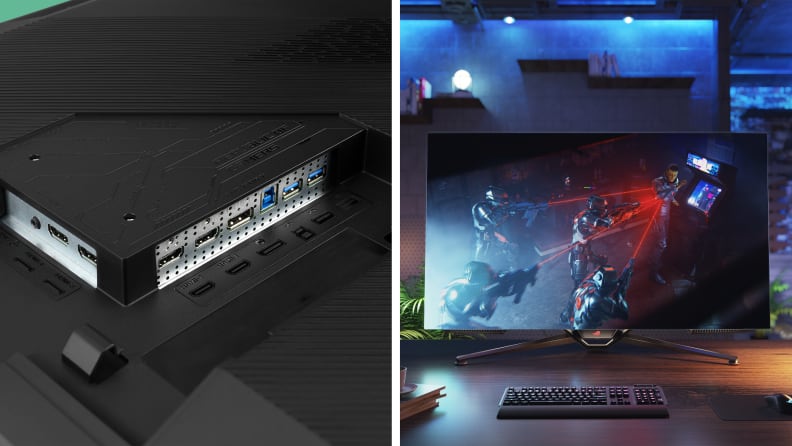
Make sure you budget some time for the setup.
The aggressive Auto Brightness Limiter
The OLED panel on the ROG Swift OLED PG42UQ might be able to hit some impressive brightness levels, but it can only do it for a small portion of the screen at a time. To prevent burn-in, it simply doesn’t push all of its pixels to their peak brightness all at the same time.
This is where the Auto Brightness Limiter (ABL) comes in, preventing too much of the display from getting too bright at once. In many cases, this is no distraction at all, with it almost never coming to my attention while watching video content.
But, it comes up a ton while using the monitor for everyday work and far more often than I’d like while gaming. With Word documents open, the display has to contend with a large section of bright white screen, and it quickly dials back the brightness. This can be distracting and sometimes the display dims the windows to hard-to-see levels if HDR is turned on.
Meanwhile, in games, it can happen at the worst times. I’d be in the middle of a team fight in Overwatch 2, and catching a Firestrike from Reinhardt, or being the focus of a Zarya beam, would push the display too hard and suddenly everything around the effect would go very dim. It made a sticky spot even stickier. I couldn’t get my bearings to react and escape the situation.
Asus has a workaround with its “Uniform Brightness” mode, which sets a low, comfortable level for white to peak around (about 120 nits). At this level, the display can happily handle a full white display, so it won’t show the distracting dimming. But it’s a big trade-off, as non-OLED monitors don’t deal with this issue at all, happy to push their full display to its peak brightness level at any time.
The fussy setup
While some monitors work perfectly out of the box, getting the ROG Swift OLED PG42UQ set up is an effort from the very start. Not only because of its size, but because of the technology involved. For starters, it comes locked into an Eco mode that effectively restricts most adjustments. Even volume controls for the built-in speakers are disabled.
Disabling the Eco mode and switching to the standard power mode opens up these options, which is key for getting a good picture. However, because of the ABL, it’s an uphill battle. Trying to take measurements on this monitor was a monstrous task, as the full-screen visuals aren’t always an accurate representation of how they’d appear on just a small section of the display.
This was no more apparent than when measuring the gray ramp of the display. In the test, the display goes from black to white in small steps. But, at a certain point, the display just simply won’t get brighter in a full-screen window; I can plainly see it get dimmer toward the end of the test instead of brighter. This makes for a skewed measurement. Retesting with the display window shrunk down (using the monitor’s built-in Aspect Control, a fussy feature in and of itself), I saw a substantially improved gray ramp.
Not knowing how the display will react from one image to the next just about rules the ROG Swift OLED PG42UQ out for any work where accurate color is essential, which is a shame because the display has a large color gamut and should be accurate with an average color variance below a delta-E of 2, even coming pre-calibrated. But, no matter how I tweaked my testing, I couldn’t get measurements that backed up this performance.
I’ll also briefly mention color fringing, which can see colors appear where there shouldn’t be any or where they should be different. This was present on the monitor and is a common issue for OLED displays because of their subpixel layout. It’s most common on text, and thin lines or hard borders between colors.
I was able to almost completely eradicate it through the use of the Better ClearType Tuner, but it would still show faintly on the edges of yellow and magenta.
The dominance it has over a desk
There’s no way around it. This monitor is huge; 41.5 inches is about as small as you’re going to find a standalone OLED monitor. That is, without dipping into the tiny, portable monitor market or going for an extremely pricey professional monitor meant for design work.
It’s a lot tamer than earlier OLED computer monitors or televisions, which range from 48 inches to 55 inches, but it’s still going to dominate a desk. This can make setting it up a headache, and accessing ports is much harder than on a monitor that you can simply turn around on its stand.
It’s impressive that Asus kept the ROG Swift OLED PG42UQ from taking up too much space depth-wise, as the stand the monitor sits on reaches only slightly forward. It’s well balanced, and even has a small range of vertical tilt adjustments. But it doesn’t leave a lot of room for much else on a desk beyond a keyboard and mouse.
Should you buy it?
Yes, if you’re willing to put in the effort
For all its fuss, the ROG Swift OLED PG42UQ is still a gorgeous monitor. Tweaking settings can help get past some of the glaring issues, and most content doesn’t see the troublesome Auto Brightness Limiter actually come into play. As long as you’re willing to put in the work, it’s a great display for work and play alike.
It may not be quite as stunning as the similarly priced Alienware AW3423DW, but it provides a lot more screen space and doesn’t run into the same issues with limited support for a 21:9 aspect ratio.
It’s also on the expensive side, but fast 4K monitors almost all come at a considerable premium, though some have come down in price since their launch. The 4K, 144Hz Gigabyte M32U, for instance, is available for $680, but it’s much smaller, has motion blur issues, and doesn’t come close to matching the visuals of an OLED panel. The Gigabyte AORUS FV43U is a similar size and hits 144Hz for only $699, but that speed won’t feel as potent next to the PG42UQ’s 0.1 ms response time.
Asus’s biggest threat is likely from the Gigabyte AORUS FO48U, a 48-inch 4K OLED gaming monitor that I’ve seen frequently on sale for $800 and even as little as $600. It doesn’t perform quite as well, but Asus hasn’t exactly worked out all the kinks of OLED either.
Asus’s ROG Swift OLED PG42UQ is $500 more expensive than the 42-inch LG C2, which uses the same panel. But PC gamers will likely get better mileage out of the Asus ROG Swift OLED PG42UQ thanks to its PC gaming-centric features, like DisplayPort, a USB hub, Uniform Brightness mode and its ability to sleep and wake alongside a PC. If you’re just looking to game on console, though, the LG C2 is the smarter pick.
While it won’t be for everyone, there’s a strong enough case for putting the ROG Swift OLED PG42UQ on your desk, as you can get a lot out of it if you put in the work.
Buy the ASUS ROG Swift OLED PG42UQ
Meet the tester

Mark Knapp
Contributor
Mark Knapp has covered tech for most of the past decade, keeping readers up to speed on the latest developments and going hands-on with everything from phones and computers to e-bikes and drones to separate the marketing from the reality. Catch him on Twitter at @Techn0Mark or on Reviewed, IGN, TechRadar, T3, PCMag, and Business Insider.
Checking our work.
Our team is here for one purpose: to help you buy the best stuff and love what you own. Our writers, editors, and lab technicians obsess over the products we cover to make sure you're confident and satisfied. Have a different opinion about something we recommend? Email us and we'll compare notes.
Shoot us an email
